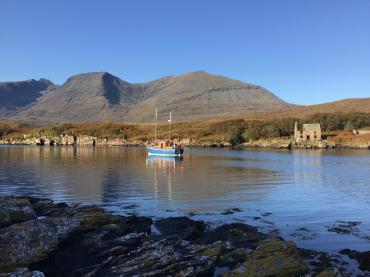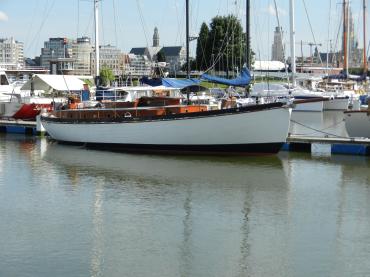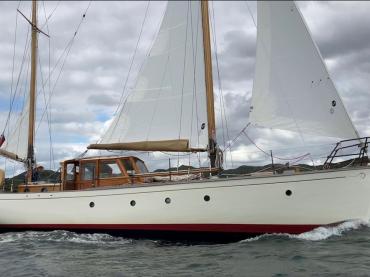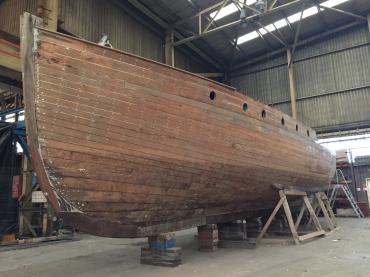
Previous names
- 1931 Windsong
Details
Construction
Dimensions
History
In 1931 the boat building yard of David Hillyard based in Littlehampton, Sussex built a yacht, listed in Lloyds Register of Yachts as a 13-ton auxiliary ketch. She was named WINDSONG. David Hillyard was an intensely religious man and it is said that each new yacht came complete with its own Bible. He also believed that an owner should be given ample time to satisfy himself with the standard of work carried out on his new purchase; consequently, he did not render his account until six months after the yacht was delivered. WINDSONG was a traditional Hillyard product: a thirty-six foot; double-ender, spoon bow and stern; centre cockpit with a simple sail plan of fore stay-sail, main and mizzen. Sadly David Hillyard's company ceased trading in 1961 after nearly ninety years of boat building during which it's believed that some 800 yachts came off his slipway. Windsong’s first owner, Norman Edwin Bartlett took delivery in July 1931.
The Certificate of British Registry (the ‘Blue Book’) describes his occupation as a gentleman. He relinquished ownership to another gentleman exactly three years later. Her third owner, Gordon Henry Dalton who lived in Brighton, took possession of Windsong in November 1936 but only enjoyed three summers of sailing before the declaration of war in September 1939 put a stop to pleasure cruising. He then laid her up in the care of Hillyard’s yard at Littlehampton for the duration of the war. However, in May 1940 the BBC broadcast an announcement that the owners of small self-propelled craft, not already requisitioned by the Admiralty, should report to Dover with their boats to assist with the evacuation of the British Expeditionary Force trapped in Dunkirk by encircling German forces. Mr Dalton had WINDSONG readied for sea and set off for Dover on the afternoon of 31st May.
He reported at 18:40 that he was "ready for sea and able to take thirty passengers" - which said more for his valour and patriotism than for the capacity of his small vessel. His boat was formally taken over by the Admiralty Small Vessels Pool and he was directed to take her to Ramsgate where he would be given sailing instructions. Windsong was equipped with a 9 hp Thorneycroft marine diesel engine, known as a 'Handy Billy’ designed for manoeuvring in harbour, not passage making across the southern North Sea. At Ramsgate, therefore, it was decided that she should be towed across to Dunkirk that night by the trawler Kinder Star in the company of five other lifeboats and small craft. I have been towed once, by the Dover Lifeboat across the channel in daylight, and it requires the helmsman's undivided attention; to be one boat in a daisy chain of six, at night, with a myriad of other craft ranging from destroyers to paddle steamers, unlit, travelling at speed in both directions through a narrow swept channel between our own and enemy minefields must have been a harrowing experience.
They arrived off the beaches north of Dunkirk in the early afternoon of the 1st of June, in the middle of an air raid by dive bombers. Mr Dalton is quoted in David Divine's book Dunkirk as saying 'We were on the point of making for the beach when we were heavily raided by dive-bombers, one large salvo just missing our trawler. We were ordered to cut adrift; it was “every man for himself”’. The 1st of June was the day when the ships in the rescue fleet suffered the heaviest losses of any single day of Operation Dynamo. To have plied back and forth, ferrying exhausted soldiers, between the beaches and larger ships lying offshore in deeper water, would have seen Windsong in an area of the greatest danger. WINDSONG was back in Dover at 21:15 on 2nd June. By any reckoning, Mr Dalton had, by then, been without sleep for over 48 hours, and was probably in no condition to make another crossing of the North Sea, so she was taken over by T.H. Falkingham and A. Barden. It is not clear if they were naval ratings or fishermen recruited for 'Operation Dynamo'. A later document refers to T.H. Falkingham and A. Barden, both of Windsong, 'who volunteered and deserve a medal'. Sadly there is no indication of what they volunteered for or how they deserved the decoration.
After Operation Dynamo she left Ramsgate in company with Sundowner – a yacht owned by Charles Herbert Lightoller, who had been the Second Officer on the Titanic when she sank in 1912 after hitting an iceberg. Together they went to Brightlingsea on the East Coast, where, under the command of a Mr Birtwhistle (a solicitor called up for the duration), she was used as a patrol and mine-spotting vessel in the Thames Estuary for the remainder of the war. Mr Dalton did not retain ownership long after the war and by 1950 Windsong went to work for her living as a charter yacht. In the course of one of these holiday charters, she was caught in bad weather in the western Channel. With all but the mizzen sail blown out and the auxiliary engine lifeless the skipper hoisted a distress signal which was eventually answered by the 600-ton German freighter SS Feronia. After a struggle, a tow-line was passed, but in the course of this the Feronia's counter came down with a sickening crunch on Windsong’s' stem post, leaving a scar she still bears today. The long tow, at five knots, up-channel then commenced, and although the tow-line parted twice, they eventually entered the Solent. By this time the Press were alert to the story, for the Feronia was the first German ship to enter Spithead since the end of the Second World War.
The fifth owner recorded in WINDSONG' ‘Blue Book’ was Lady Effie Millington-Drake, wife of Sir Eugen John Henry Vanderstegen Millington-Drake, KCMG, who had been the British Minister to Uruguay (1934–1941). At the time of the Battle on the River Plate, it was he who contrived to delay the departure of the German Pocket Battleship Graf Spee from Montevideo by a series of spurious radio messages, enabling the Royal Navy to reinforce Admiral Harewood’s cruiser force waiting outside, so that they could successfully attack the German ship when she left neutral waters. The pocket battleship was finally scuttled at the mouth of the River Plate to avoid falling into British hands. Having found Windsong in a mud berth on the River Cleddau in Pembrokeshire the current owne became her thirteenth owner in 1986. For a few weeks, I sailed her within Milford Haven before setting off with a friend and his grown-up daughter for a shake-down cruise across to Ireland. However, shortly after entering St George's Chanel, we encountered a head sea which caused WINDSONG to pitch violently breaking the mizzen mast in half, filling the cockpit with a tangle of shrouds and halyards, and fracturing two of my friend’s ribs. We limped back into Milford Haven and that evening encountered the owner of a local hotel who offered us a mast he had taken out of a fishing boat he was converting into a motor cruiser.
Though this mast was damaged in places and was much bigger than WINDSONG'S original it was gratefully accepted. After three days of work with an electric hand plain, a beautifully straight Sitka spruce mizzen mast emerged; and all for the price of a pint of beer. The two halves of the broken mizzen-mast were lashed to the side deck to be taken home, where, on a more thorough examination, it was found that the point of the break was an old scarf joint that had dried out over the years. It is highly unlikely that Hillyard’s would have fitted a mast with a scarf joint, so perhaps it was a repair to damage suffered during the war.
Later converted, the bottom half of the broken mizzen into a longer bowsprit; the existing short spar, fitted by a previous owner, had not completely cured her inherent weather-helm. Her owner was living at that time in Germany, on the border with Holland, and planned to keep WINGSONG, during the winter months, in a boatyard on the river Maas at Roermond in Holland; it was going to be a long haul from southwest Wales.
For the next six years, Windsong was moored in winter with her masts down at a yard on the river Maas at Roermond in Holland. In the summer she would motor downriver to the coast, the masts would be stepped and she would be sailed extensively in Dutch waters and the East Coast of England. In the autumn she would enter the river or canal system of the Low Countries for the return to Roermond. During the winter of 1987/88.
1990 was the fiftieth anniversary of the Dunkirk evacuation and Windsong, as a vessel registered with the Association of Dunkirk Little Ships (ADLS), in company with over seventy other surviving veterans, assembled in Dover harbour to be inspected by his Royal Highness the Duke of Edinborough, the ADLS Honorary Admiral, before setting off on the cruise to Dunkirk. Escorted by two ships of the Royal Navy, a south-easterly course was shaped to cross the busy commercial shipping lane at a right angle in the narrow straits of Dover.
In 1992 she sailed from her winter mooring on the river Maas to Cyprus in the Eastern Mediterranean. With the masts down the first month was spent negotiating the rivers and canals (and the 209 locks!) of Belgium and France. On the River Rhône, between Valence and Avignon, is the famous Bollène-écluse. It is the deepest lock on the Rhône and indeed in France. Boats gain or lose 23 meters in altitude in minutes using this lock.
Windsong is now in Trust, to the WOW Foundation for the training and recreation of young people who have been less fortunate in their experience of life's vicissitudes' than I have.
LIST OF OWNERS Norman Edwin Bartlett 1931 Charles Bernard Bond 1934 ? ? Watkins 1935 Gordon Lewis Dalton1936 Lady Effie Millington- Drake 1946 Itchenor Yacht Charters Ltd 1951 Holiday Boats Ltd 1953 Brigadier Donald Hardy Lyal Grant 1989 John Whiteford Heyet1962 Peter Walter Whitfield 1969 Stephen Murray Latham 1983 Colonel Michael Nichoas Vine Duddridge 1986
Key dates
- 1940-05-31 Departed Ramsgate for Dunkirk
- 1940-06-02 Recorded back in Dover.
Own this vessel?
If you are the owner of this vessel and would like to provide more details or updated information, please contact info@nationalhistoricships.org.uk
















